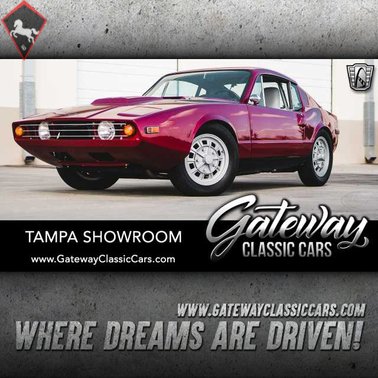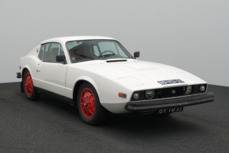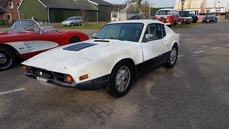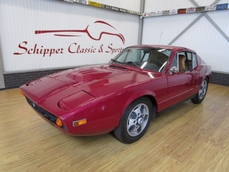Saab 97 Sonett II/III Ford Taunus V-4 Cylinder 1971
General description :
Mileage : 77251
Interior Color : Red/Grey
Exterior Color : Red Candy Metallic Tri-Coat
VIN : 71500996
Transmission Description : 4 Speed Manual
Doors : 2
Description : Gateway Classic Cars of Tampa is proud to offer this sharp 1971 Saab Sonett III. This car is claimed by its owner to have underwent restoration in 2013. During the restore, the original Ford Taunus V4 cylinder engine was rebuilt with new gaskets and seals, the heads were machined and valves lapped, new rings and cylinders honed, the bottom end is original and didn't need rebuilding, the exhaust system was replaced, and even the 4 speed manual transmission was rebuilt with the freewheel locked out(all claimed by its owner). The engine did receive some upgrades such as its Weber 34ICH Carburetor, Classic Auto Air under dash A/C system, aluminum radiator, electric fan, and so much more. The odometer reads 77,251 miles but the rebuilt on this drivetrain was done only about 500 miles ago. The tub was sandblasted, trunk floor replaced, and painted with POR-15. All of the suspension components were powder coated satin black, new shocks/bushings/ball joints/ brake lines/ fuel lines/ and braking components were replaced as well. Painted in a sharp Ford RZ Red Candy metallic tri-coat paint that looks amazing and flows well with the two-tone red and gray leather interior. The total production in 1971 was 1265 units and total production for all manufactured years, 1966-1974, was 10,236 units. As this unique car gets older, it will only be harder and harder to find one, especially in this condition.
This 1971 Saab Sonett III is for sale by our Tampa Showroom and can be viewed in greater detail including 100+ HD pictures and an HD video at http://www.GatewayClassicCars.com. For additional information, please call our knowledgeable staff at (813)645-6200 or email us at Tampa@GatewayClassicCars.com.
See more at http://www.gatewayclassiccars.com/TPA/1733/1971-Saab-Sonett-III
https://www.gatewayclassiccars.com/vehicle/TPA/1733/1971-Saab-Sonett-III
1971 Saab 97 Sonett II/III Ford Taunus V-4 Cylinder is listed sold on ClassicDigest in Ruskin by Gateway Classic Cars for $16500.
Car Facts
Car type : Car Make : Saab Model : 97 Sonett II/III Model Version : Ford Taunus V-4 Cylinder Engine size : 0.0 Model Year : 1971 Location : Tampa
Sold
Seller Information
Sold
People who viewed this Saab 97 Sonett II/III also viewed similar Saab listed at ClassicDigest
Other cars listed for sale by this dealer
About Saab
Saab, originally an acronym for Svenska Aeroplan Aktiebolaget (Swedish Aeroplane Company), began its journey as an aircraft manufacturer in 1937. Founded in Sweden, Saab's primary focus was on producing fighter planes and military aircraft. Over time, the company diversified its interests and ventured into automobile manufacturing, which eventually led to the creation of quirky yet innovative cars that stood out in the automotive industry.Fighter Plane Manufacturing:
Saab's history in the aviation industry was marked by its production of innovative fighter planes. One of its most iconic aircraft was the Saab 29 Tunnan, introduced in the early 1950s. The Tunnan was notable for its unique design, featuring a barrel-shaped fuselage, which earned it the nickname "The Flying Barrel." It was powered by a single jet engine and became Sweden's first domestically produced jet-powered fighter aircraft.
Following the success of the Tunnan, Saab continued to develop advanced military aircraft. The Saab 35 Draken, introduced in the late 1950s, was another milestone for the company. The Draken was a delta-winged interceptor known for its remarkable speed and distinctive double-delta wing configuration. Its innovative design allowed for excellent maneuverability and performance, making it a significant asset in Sweden's air defense arsenal for several decades.
Transition to Automobile Manufacturing:
In the late 1940s, Saab expanded its operations into the automotive industry. The company's first foray into car manufacturing resulted in the production of the Saab 92, which debuted in 1949. The Saab 92 was a compact and aerodynamic car powered by a two-cylinder, two-stroke engine. Its unconventional design, with a streamlined shape and front-wheel-drive layout, set it apart from other cars of its time.
As Saab continued to innovate, it introduced several notable models in the automotive market. The Saab 99, launched in the late 1960s, was a significant milestone for the company. It featured distinctive styling, including a wraparound windshield and a unique "hockey stick" profile, giving it a recognizable appearance. The Saab 99 also introduced technical advancements such as turbocharging, enhancing performance and fuel efficiency.
The evolution continued with the Saab 900, introduced in the late 1970s, which became one of the company's most iconic models. The Saab 900 was known for its robust build quality, innovative safety features, and unconventional design elements, including the signature wraparound windshield. It offered turbocharged engines and a versatile hatchback body style, catering to a niche market seeking individuality and practicality.
Technical Aspects and Quirks:
Saab cars were characterized by their technical innovations and unique features. Some of the standout technical aspects and quirks of Saab automobiles include:
Turbocharging: Saab was one of the pioneers in popularizing turbocharged engines in passenger cars, significantly enhancing power output without sacrificing fuel efficiency.
Safety Innovations: Saab prioritized safety and introduced various safety features, including reinforced passenger compartments, impact-absorbing structures, and advanced braking systems.
Aircraft-Inspired Design: The company incorporated design elements inspired by its aviation heritage, such as aerodynamic shapes, wraparound windshields, and unconventional styling cues.
Ergonomics and Practicality: Saab cars were known for their comfortable interiors, innovative ergonomics, and practical features like the ignition key placement between the front seats.
Quirkiness: Saab cars often featured unconventional design choices and solutions, appealing to a niche audience seeking something different from mainstream automobile offerings.
Saab's journey from a renowned fighter plane manufacturer to a builder of quirky yet innovative cars highlights its commitment to innovation, unique design, and technological advancement in both the aviation and automotive industries. Despite facing challenges and changes in ownership over the years, Saab's legacy endures through its distinct and unconventional approach to vehicle design and engineering.
























